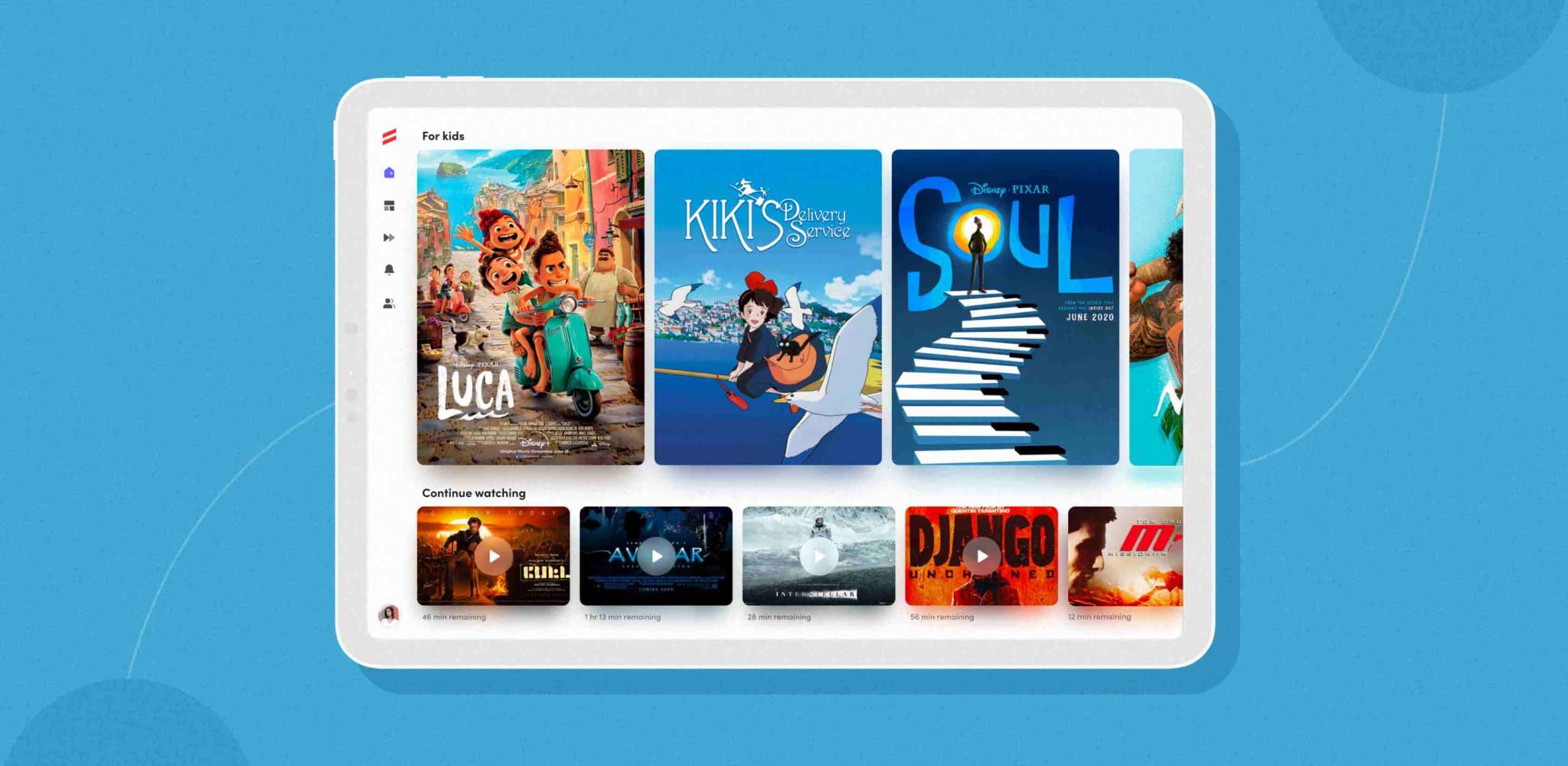Over-the-Top (OTT) platforms have become the go-to for on-demand content delivery in the fast-paced world of media consumption. As we step into 2024, the OTT landscape is more vibrant than ever, with an array of providers catering to diverse audience preferences. In this comprehensive guide, we will explore the major players, market trends, factors influencing choices, and the future of OTT.
What is an OTT platform?
Over-the-Top platforms have transformed the way we experience media. In essence, OTT platforms deliver content directly to users over the internet, bypassing traditional distribution methods. This approach offers unparalleled flexibility, allowing users to consume their favorite shows, movies, and other content on a variety of devices, whenever and wherever they choose.
An overview on OTT platform market
The Over-the-Top (OTT) market is painting the entertainment landscape with vibrant hues, and the canvas is far from complete. OTT platform, delivers video, audio, and other media content straight to your devices, is projected to surpass a whopping $434.5 billion by 2027, boasting a Compound Annual Growth Rate (CAGR) of 16.5%.
Fueled by the internet’s rising penetration and our insatiable appetite for on-demand content, the OTT platform market is exploding with over 4.4 billion users worldwide. This translates to nearly half the global population tuning into their favorite shows and movies whenever, wherever they please.
Factors to consider when choosing an OTT platform
In the ever-expanding world of OTT platforms, the key to success lies in selecting the right platform that aligns with your goals and caters to the needs of your audience. This decision is multifaceted, encompassing various crucial factors that can significantly impact the overall performance and sustainability of your OTT platform venture.
Content Variety: One of the primary considerations when choosing an OTT platform is the diversity and quality of content it offers. The platform should provide a wide range of content types, catering to different tastes and preferences. Whether it’s movies, TV shows, live events, or exclusive original content, a robust library ensures that your audience remains engaged and satisfied.
User Experience: A seamless and enjoyable user experience is paramount for the success of any OTT platform. The user interface should be intuitive, easy to navigate, and visually appealing. Features such as personalized recommendations, easy content discovery, and a user-friendly playback experience contribute to a positive overall impression. A platform that understands and prioritizes user experience can significantly enhance viewer retention and satisfaction.
Scalability: The ability of an OTT platform to scale with your growing audience is critical. As your user base expands, the platform should seamlessly accommodate increased demands on resources and ensure a consistent and reliable streaming experience. Scalability is not just about handling larger audiences but also adapting to technological advancements and evolving industry standards.
Monetization Options: Monetization is a key aspect of any OTT platform business model. The chosen platform should offer diverse and flexible monetization options to suit your revenue strategy. This may include subscription models, pay-per-view, advertising, or a combination of these. The platform should provide robust tools for content creators and businesses to effectively monetize their content while delivering value to the audience.
Technical Infrastructure: The underlying technical infrastructure of the OTT platform is a critical consideration. Factors such as video quality, adaptive streaming capabilities, and support for various devices (smartphones, tablets, smart TVs, etc.) play a significant role. A reliable infrastructure ensures smooth content delivery, minimizes buffering, and provides a consistent viewing experience across different devices and network conditions.
Analytics and Insights: Data-driven decision-making is essential for optimizing content strategies and improving user engagement. The OTT platform should provide comprehensive analytics and insights into viewer behavior, content performance, and audience demographics. Access to these analytics empowers content creators and businesses to refine their strategies and cater to the specific preferences of their audience.
Security and DRM: Protecting your content and ensuring secure delivery is crucial in the digital landscape. The OTT platform should implement robust digital rights management (DRM) solutions to prevent unauthorized access and content piracy. Security measures should also extend to user data protection, ensuring compliance with privacy regulations.
Integration Capabilities: For businesses and content creators, integration capabilities with other tools and services are essential. The OTT platform should allow seamless integration with payment gateways, advertising networks, customer relationship management (CRM) systems, and other third-party services. This integration streamlines operations and enhances the overall efficiency of your OTT ecosystem.
Top 12 OTT Platform Providers
As we navigate the dynamic landscape of OTT platforms in 2024, a myriad of providers stands out, each bringing unique features and solutions to the table. Let’s explore the noteworthy players that are shaping the future of OTT streaming.
Wowza: Wowza distinguishes itself with a robust set of features catering to both content creators and consumers. Its live streaming capabilities, coupled with advanced analytics and customizable solutions, position Wowza as a standout player in the OTT industry, providing a versatile and high-quality streaming experience for users.
IBM: IBM, a tech giant, solidifies its presence in the OTT industry by extending beyond traditional streaming. With a focus on innovation, IBM incorporates AI and cloud-based solutions, enhancing the overall viewing experience and reflecting the company’s commitment to cutting-edge technology in the OTT space.
Vimeo: Vimeo has etched its place as a reliable and preferred OTT platform. Known for its commitment to high-quality streaming services and customization options, Vimeo continues to be a favorite among content creators, providing a platform that empowers creative expression and engagement.
Brightcove: Brightcove’s comprehensive platform offers a suite of tools for content management, distribution, and monetization. With a user-friendly interface, it stands as a preferred choice for businesses of all sizes, streamlining the process of delivering and monetizing content effectively.
Muvi: Muvi’s all-in-one platform simplifies OTT streaming for businesses. From seamless content delivery to robust monetization features, Muvi provides an end-to-end solution, ensuring a hassle-free experience for both content providers and viewers.
VPlayed: VPlayed specializes in providing white-label OTT platform solutions, catering to a diverse range of businesses. Its features, including multi-device compatibility and secure streaming, make it a reliable choice for those looking for a customizable and versatile white-label solution.
Kaltura: Kaltura stands out as a versatile player in the OTT landscape. Its open and flexible platform allows for easy integration, making it suitable for various industries seeking a customizable and adaptable OTT platform solution.
Brid.tv: Brid.tv offers a comprehensive OTT platform solution with a specific focus on video monetization. Its ad management tools and analytics contribute to a holistic streaming experience, providing businesses with the tools needed for effective monetization strategies.
JW Player: Renowned for its advanced video player technology, JW Player focuses on delivering high-quality video content. Positioned among the top-tier OTT providers, JW Player ensures an immersive and seamless video streaming experience for its users.
Yondo: Yondo stands out with its emphasis on live streaming solutions. From facilitating virtual events to supporting online classes, Yondo’s platform is versatile and supports diverse streaming needs, providing an engaging and interactive user experience.
Streann: Streann takes an innovative approach to OTT streaming by incorporating interactive features like gamification and social integration. This creates an engaging user experience, making Streann a noteworthy player in the evolving landscape of OTT platforms.
MAZ Systems: MAZ Systems excels in providing tailored OTT platform solutions for content publishers. Its platform enables seamless content delivery across various devices, reflecting MAZ Systems’ commitment to facilitating content distribution for publishers with efficiency and effectiveness.
Tailor Your Streaming Strategy: Consult with Our OTT Experts Today!
What are the latest trends in Custom Software Development?
In the ever-evolving landscape of custom software development, staying abreast of the latest trends is essential. These trends not only define the current state of the industry but also pave the way for innovative solutions that cater to the diverse needs of businesses. Let’s delve into each trend with detailed descriptions:
Progressive Web Apps (PWA): Progressive Web Apps seamlessly bridge the gap between web and mobile applications, offering users reliability, speed, and offline capabilities. They utilize modern web capabilities to deliver an app-like experience, ensuring a superior user experience. PWAs are not only responsive but also provide a consistent experience across various devices, making them a pivotal trend in enhancing user engagement.
Web 3.0: Web 3.0 marks the next phase of the internet, introducing decentralized applications (dApps) and elevating user experiences. This trend leverages technologies like blockchain to create a more secure and interactive internet environment. With a focus on decentralization, Web 3.0 aims to redefine the way users interact with online content and services, fostering transparency and security in the digital realm.
The Internet of Behaviour (IoB): IoB harnesses the power of data analytics to comprehend and influence human behavior, offering businesses valuable insights. By understanding customer behavior, businesses can enhance customer experiences and optimize decision-making processes. IoB not only shapes personalized user experiences but also empowers businesses to make informed strategic decisions based on data-driven insights.
Microservices Architecture: Microservices Architecture is a paradigm shift in custom software development, involving the breakdown of applications into smaller, independent services. This approach enables easier development, maintenance, and scalability. Each microservice operates as a standalone unit, fostering agility in development and allowing businesses to adapt quickly to changing requirements. This architectural trend enhances flexibility, making it a cornerstone in modern software development.
DevSecOps: DevSecOps integrates security seamlessly into the DevOps process, ensuring that security measures are an integral part of the custom software development lifecycle. By prioritizing security from the outset, this trend promotes collaboration between development, security, and operations teams. DevSecOps not only enhances the speed of development but also ensures that security is a proactive and continuous aspect of the custom software development process.
Internet of Things (IoT): The Internet of Things connects devices and systems, facilitating data collection, analysis, and automation. This trend fosters efficiency across various industries by enabling seamless communication between devices. From smart homes to industrial processes, IoT transforms the way businesses operate, opening new avenues for innovation and optimization.
Low-Code and No-Code Platforms: Low-code and no-code platforms empower users with varying technical skills to actively participate in the development process. These platforms streamline application development by minimizing manual coding efforts. This trend democratizes custom software development, allowing business users to contribute to the creation of applications, thereby accelerating the development lifecycle.
Cloud Computing: Cloud computing provides scalable and flexible infrastructure, promoting collaboration, accessibility, and resource optimization. This trend enables businesses to leverage on-demand computing resources, reducing the need for physical infrastructure. Cloud computing not only enhances collaboration but also allows businesses to scale their operations efficiently.
Infrastructure as Code (IaC): IaC automates and manages IT infrastructure through code, streamlining deployment processes and ensuring consistency. This trend enables the automation of infrastructure provisioning, configuration, and management. By treating infrastructure as code, businesses can achieve faster and more reliable deployments, minimizing manual errors and ensuring a standardized environment.
Chatbots and Virtual Assistants: AI-powered chatbots and virtual assistants enhance customer interactions, providing real-time support and improving user satisfaction. This trend leverages artificial intelligence to create intelligent conversational interfaces. Chatbots not only streamline customer support but also contribute to a personalized user experience, making them valuable assets in various business applications.
How does OTT App Development takes place?
OTT app development is a meticulous process that encompasses various stages, each contributing to the creation of a seamless and user-friendly application.
Conceptualization: At the core of OTT app development lies the conceptualization phase. This is where the vision for the application takes shape. Developers collaborate with stakeholders to define the app’s purpose, target audience, features, and overall functionality. Market research is conducted to understand user preferences, industry trends, and potential competitors. By the end of this phase, a clear roadmap for the app’s development is established.
Design: The design phase focuses on creating an intuitive and visually appealing user interface (UI) and user experience (UX). Designers work on wireframes and prototypes, considering factors such as navigation, layout, and aesthetics. The goal is to ensure that users can easily navigate the app while enjoying a visually engaging experience. The design phase often involves feedback loops with stakeholders to refine and improve the overall design.
Development: The actual development of the OTT app takes place in this stage. Developers write the code, implement features, and integrate functionalities based on the specifications outlined in the conceptualization and design phases. It’s crucial to ensure that the app is optimized for various devices, operating systems, and screen sizes. This stage involves close collaboration between developers, designers, and other specialists to bring the envisioned app to life.
Content Integration: For OTT apps, content is a vital component. This stage involves integrating the app with the necessary content delivery systems, ensuring seamless streaming capabilities. Developers work on incorporating features like video playback, content categorization, and search functionalities. Security measures are also implemented to protect both the content and user data.
Testing: Quality assurance is paramount in OTT app development. The testing phase involves rigorous testing of the app’s functionality, performance, and security. This includes compatibility testing across various devices and platforms, load testing to assess the app’s responsiveness under different loads, and security testing to identify and rectify vulnerabilities. Testing helps ensure that the app meets quality standards and provides a reliable user experience.
Deployment: Once the app has passed through the testing phase, it is ready for deployment. Deployment involves making the app available to users on app stores and other distribution platforms. Developers handle the technical aspects of deployment, ensuring that the app is properly configured and accessible to users. This phase may also involve promotional activities to increase visibility and encourage downloads.
Post-Launch Support and Updates: The launch of the OTT app is not the end of the development process; it marks the beginning of a new phase. Post-launch support involves monitoring the app’s performance, addressing any issues that may arise, and providing ongoing support to users. Additionally, developers continue to work on updates and enhancements based on user feedback, technological advancements, and changing market trends.
How much does it cost for OTT app development?
What is the future of Video OTT platform?
Conclusion
Let’s transform your business for a change that matters.
F. A. Q.
Do you have additional questions?
What is an OTT platform, and how does it differ from traditional media services?
An OTT (Over-the-Top) platform delivers content directly to users over the internet, bypassing traditional cable or satellite services. Unlike traditional media services, OTT platforms offer on-demand access to a diverse range of content on various devices without the need for a cable or satellite subscription.
Why are personalized content recommendations considered a key trend in the future of video OTT?
Personalized content recommendations leverage advanced algorithms and machine learning to analyze user preferences and viewing habits. This trend ensures that users receive tailored content suggestions, enhancing their viewing experience and encouraging prolonged engagement.
How do AR and VR technologies contribute to reshaping the viewing experience on OTT platforms?
Augmented Reality (AR) and Virtual Reality (VR) technologies create immersive and interactive content experiences on OTT platforms. Users can engage with content in novel ways, such as virtual tours or interactive narratives, providing a more captivating and personalized viewing experience.
What factors should businesses consider when choosing an OTT platform provider?
Businesses should consider factors such as content variety, user experience, scalability, and monetization options when choosing an OTT platform provider. The ability to adapt to evolving trends and technological advancements is crucial for long-term success in the dynamic OTT industry.
How does enhanced interactivity in OTT platforms impact user engagement?
Enhanced interactivity in OTT platforms, such as live polls, interactive narratives, and viewer participation, fosters a sense of involvement. This dynamic engagement not only keeps users interested but also creates a more interactive and personalized viewing experience.
What are the anticipated advancements in streaming quality on OTT platforms?
Anticipated advancements in streaming quality include higher resolutions, improved frame rates, and reduced latency. These enhancements aim to provide users with a seamless and high-fidelity streaming experience, especially crucial for live events.
How can Artificial Intelligence (AI) impact content creation and curation in the OTT industry?
AI can revolutionize content creation and curation in the OTT industry by analyzing trends, viewer feedback, and market demands. Automated systems can generate content ideas, streamline production workflows, and ensure that the content aligns with audience preferences, leading to more efficient and tailored content delivery.
Why is the globalization and localization of content becoming crucial for OTT platforms?
Globalizing and localizing content on OTT platforms is crucial to cater to diverse global audiences. While expanding international content libraries, there is a simultaneous effort to tailor content to specific regional tastes, ensuring a more personalized and culturally relevant viewing experience.
What is the significance of Blockchain in ensuring security and monetization on OTT platforms?
Blockchain technology ensures security on OTT platforms by providing decentralized and transparent systems. This technology protects against piracy, safeguards content distribution integrity, and offers transparent monetization models, benefiting both content creators and consumers.
How can businesses initiate the development of a custom OTT platform tailored to their needs?
Businesses can initiate the development of a custom OTT platform by reaching out to experienced professionals in the field. Discussing aspirations, requirements, and technological possibilities with a dedicated team can pave the way for a tailored solution that meets specific business needs and objectives.














